-
What is tissue? (general def)
a group of cells with similar structure and fcn
-
What are the four major tissue types and their associated examples?
1. Nervous tissue (brain, spinal cord, nerves)
2. Muscle tissue (skeletal, cardiac, smooth)
3. Epithelial tissue (Lines Gi tract & other hollow organs, skin surface)
4. Connective tissue (Bones, tendons, fat & other soft padding)
-
What fluid are the cells of most tissues surrounded by?
An extracellular fluid called interstitial fluid -- which is mostly water and ions
-
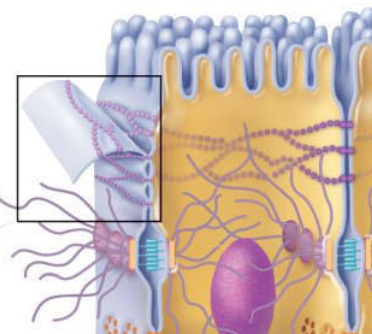
What cell junction is this?
Tight junction
-
What are cell junctions?
- Points of contact between adjacent cells in seen epithelial tissue, some nervous and muscle cells
- formed by cell membrane proteins
-
What are the 3 types of cell junctions?
Tight, anchoring (i.e. desmosomes), and gap junctions
-

What type of cell junction is this?
Gap junction
-
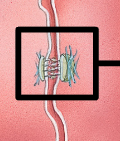
What type of cell junction is this?
Desmosomes/anchoring junction
-
What are tight junctions?
- partial fusion of specific proteins on the lateral surface of the cell membrane that forms a ring like tight seal
-
Which cell junction stops cells like bacteria, proteins, and sometimes fluid/ions (depending on the tissue) from passing through?
The tight junction
-
What do desmosomes do?
Anchoring junction
- Proteins that fasten cells to each other and/or extracellular material
-
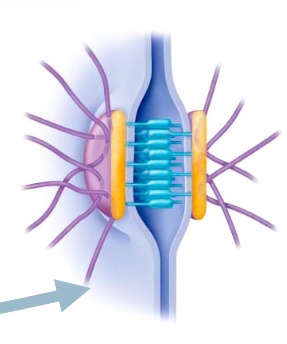
What cell junction is this?
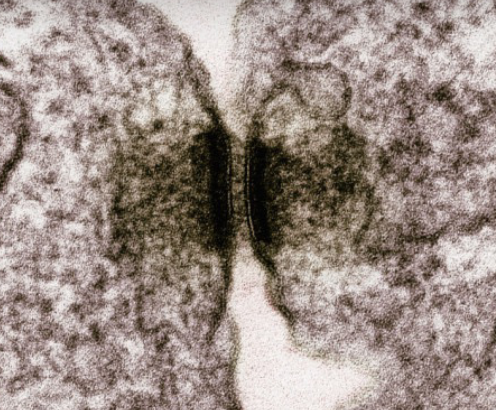
Anchoring junction/desmosomes
-
What does the gap junction do?
- has open channels formed by proteins through adjacent cell membranes (connecting their cytosols)
- allows ions/small molecules to pass between the cells
this allows cells to work as a unit (important for synchro of contractions in cardian and smooth muscles)
-
What do tight junctions do?
- stop integral proteins from moving between the apical and basolateral surfaces of the cell
-
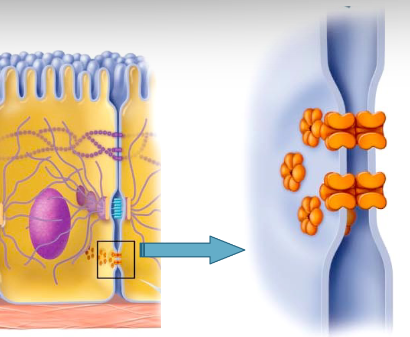
What type of cell junction is this?
Gap junction
-
What are the characteristics of epithelial tissue?
- has one free surface
- little extracellular space between cells
- avascular (no blood vessels)
- basement membrane (attaches epithelium to underlying connective tissue layer)
-
What is the naming classification of epithelia? When does it not apply?
First name (based on layers):
- if one layer (simple), if more (stratified)
Last name (based on shape, look at top layer to categorize):
- flattened (squamous), round/cubed (cuboidal), rectangular (columnar)
doesn't apply if the cells form a secretion gland
-
What are the characteristics of simple epithelia?
- only one layer of cells
- allows exchange of molecules (gasses, nutrients, ions)
- simple squamous (lungs), simple cuboidal (kidneys), simple columnar (stomach, small intestine)
-
what is epidermis?
The outer most layer of skin on your body
-
What are the characteristics of stratified epithelia?
- more than one layer of cells
- protective of areas of abrasion (main fcn)
- predominant subtype is stratified squamous, which is apical cells squished (epidermis of skin)
-
What are the functions of epithelia?
- protection (our skin is protection, stratified squamous)
- secretion (glandular epithelium)
- Allows selective passage of materials (nutrients, waste, water, ions) across membranes (typically this is simple epithelia)
-
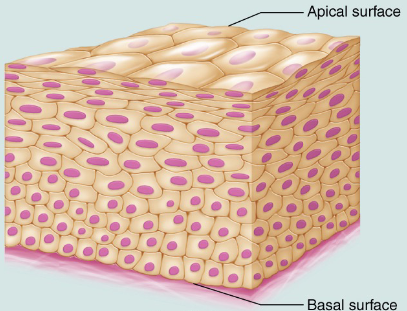
What type of epithelial is this?
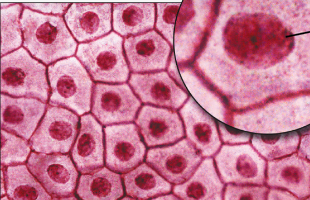
Stratified squamous, here's surface view
-
What is Pseudostratified epithelia?
- 1 layer of columnar cells that appear stratified, bc some cells are shorted/nuclei appear at different levels. But all cells sit on basement membrane so its simple
- lines most of respiratory tract
-
What is transitional epithelia?
- cell shape and layers vary because of stretching
- Only exists in inner lining of urinary system
- cuboidal to squamous when stretched
-
What is glandular epithelium?
- used for secretion (so no longer in naming convention)
- the epithelial cells form a gland
subtypes: exocrine (substance) and endocrine (hormones) glands
-
What are exocrine glands and what do they do?
- secret products onto body surfance or into cavity
can be:
- Unicellular, (secrete mucus into cavity, in digestive, reproductive, and respiratory tracts) e.g. goblet cells
- Multicellular, secretory and duct cells (ducts connect secretions to surface or cavity) e.g. sudoriferous (sweat glands), sebaceous (oil)
-
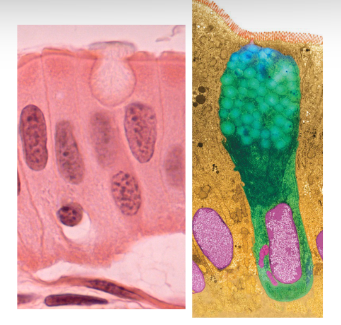
What kind of gland is this?
Unicellular exocrine gland, of glandular epithelium tissue
-
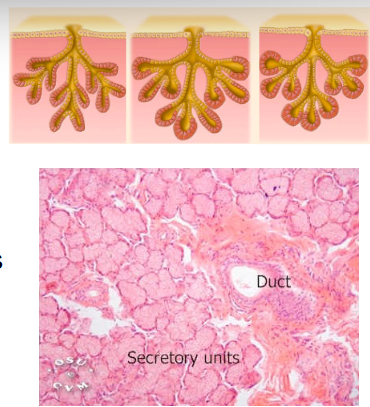
What kind of gland is this?
Multicellular exocrine gland, of glandular epithelium tissue
-
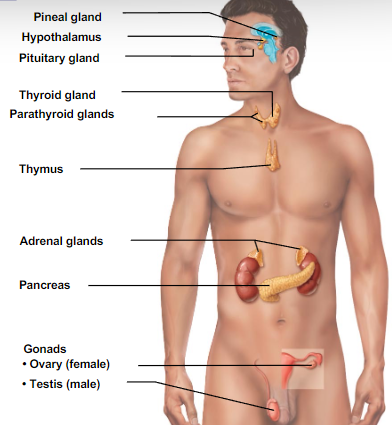
What subtype of glandular epithelium are these glands?
Endocrine (ductless)
-
What is the general role/fcn of connective tissue?
- mainly supports and connects tissues
- the cells are far apart and separated by extracellular matrix (which usually forms the bulk of the tissue
the extracellular matrix gives connective tissue (CT) subtypes their identifying characteristics
- variable vascularity
-
What is the connective tissue cell type logic?
CT cell types ending in:
-blast (create the matrix, e.g. osteoblast)
-cyte (maintain the matrix, e.g. osteocytes)
-clast (break down the matrix, e.g. osteoclast)
-
What is the matrix composition of connective tissue?
1. Fibres (proteins)
- collagen fibres for strength, elastic fibres for containing elastin (allow stretch and recoil), reticular fibres to form networks (e.g. the connective tissue part of basement membrane)
2. ground substance
- water (ISF) and large organic molecules (proteins & carbohydrates) surrounding cells and fibres,
-
What are all of the different connective tissue classifications (mainly based on matrix composition)?
Connective tissue proper (loose and dense ct), cartilage, bone, blood
-
What cells form connective tissue proper and what are the types?
cells: fibroblasts/fibrocytes (except adipose tissue, then adipocytes)
1. loose connective tissue
2. Dense connective tissue
-
What are the characteristics and subtypes of loose connective tissue (type of ct proper)?
1. areolar connective tissue
- loosely arranged collagen and elastin fibres, highly vascular
2. Adipose connective tissue
- very little matrix, large cells (adipocytes) store triglycerides, highly vascular and looks like chicken wire
-
What are the characteristics and subtypes of dense connective tissue (type of ct proper)?
- many fibres (so known as fibrous ct), little ground substance, poorly vascular
1. dense regular connective tissue
-collagen fibres running in same direction (e.g. ligaments which connects bone to bone
2. dense irregular connective tissue
- collagen fibres arranged irregularly (e.g. dermis of skin)
-
What are the characteristics of cartilage?
- large amounts of matrix
- made of fibres (collagen & elastin) and a ground substance of water
- Avascular
- 3 types: hyaline cartilage, elastic cartilage, fibrocartilage
-
What are the cells that form cartilage?
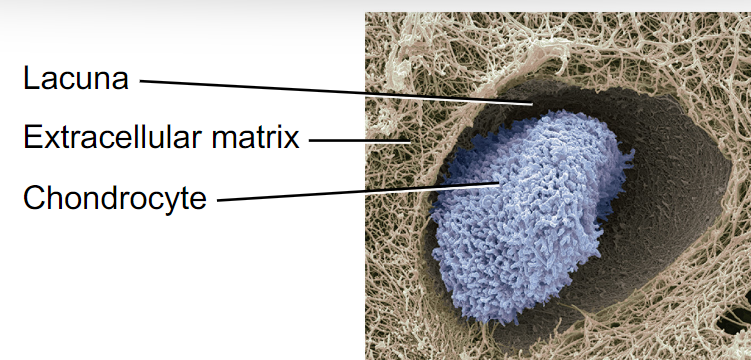
Chondrocytes (located in cavities in the matrix called lacunae) and chondroblasts
-
What are the types of cartilage?
1. hyaline cartilage (most abundant, at ends of long bones (like ribs) to reduce friction)
2. elastic cartilage (can recoil and maintain shape, e.g. ear pinna)
3. fibrocartilage (high in collagen fibres, work as shock absorbers)
-
What cells form the bone ct type?
osteocytes (in lacunae), osteoblasts, osteaclasts
-
What are the characteristics of the ct type bone?
- large amounts of matrix
- fibres have abundant collagen
- ground substance of inorganic calcium (Ca++), phosphate salts, and organic components (proteins & carbohydrates) make it rigid
- very vascular
-
What are the characteristics of the ct type blood?
- fluid connective tissue
- cells: red blood cells, white blood cells, platelets
- extracellular matrix is called plasma which contains soluble fibres (e.g. fibrinogen for blood clotting) and ground substance is mostly water with ions and proteins
-
What are the characteristics of muscle tissue and its subtypes?
- Contractile tissue
- subtypes: skeletal, cardiac, smooth
-
What are the characteristics of the subtypes of muscle tissue?
1. skeletal (striated, and a voluntary muscle)
2. cardiac (striated, and involuntary muscle)
3. smooth (non-striated, cant contract, its around arteries and organs)
-
What are the cell types in nervous tissues?
- neurons (which conduct electrical impulses)
- glial cells (support and protect neurons)
-
Which tissue types are avascular?
- some CT: Cartilage,
- epithelia
- nervous tissue
-
Which tissue types are vascular?
- skeletal &smooth muscle tissue
- some CT: loose connective tissue (dense is very poorly vascular), bone, blood

